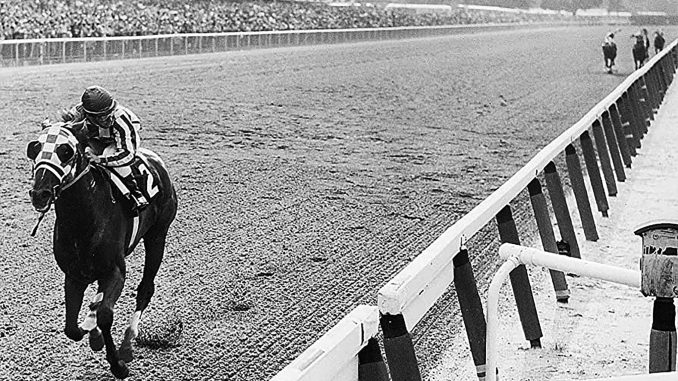
“Secretariat is moving like a tremendous machine.”
Who can forget Chic Anderson’s famous line as Big Red raced down the finish line in the 1973 Belmont Stakes to win that year’s Triple Crown.
The years have not diminished the horse’s legendary run through history.
In a field of only five horses, Secretariat broke out of the gate early, winning by 31 lengths, the largest margin of victory in Belmont history. His winning time of 2 minutes and 24 seconds is also a mark for dirt field racing.
Secretariat’s great rival was Sham, who in another year might also have dominated. The two started out evenly during the first turn and even into the half-mile mark.
Entering the backstretch and approaching three-quarters of a mile, Secretariat maintained his torrid pace as Sham began to fade, ultimately finishing last. At the three-quarters mile marker, Big Red took over. Sham began to falter, while Secretariat maintained his lightning fast speed. The horse pulled away and extended his lead with an incredible stretch run. In the post-race analysis, it was discovered that Sham had suffered a hairline fracture of his right front cannon bone during the race, which ended his racing career.
With the Belmont win, Secretariat became the ninth horse to win the Triple Crown, combining Belmont with wins in the Kentucky Derby and the Preakness Stakes. Big Red also broke a 25-year drought where no horse had completed the achievement. The last one to do so was the equally immoral Citation, who completed the feat in 1948.
As the race approached, Secretariat was already a national hero, appearing on the covers of several national publications.
“Secretariat suddenly transcended horse racing and became a cultural phenomenon, a sort of undeclared national holiday from the tortures of Watergate and the Vietnam War,” wrote William Nack.
After the race, jockey Ron Turcotte said: “This horse really paced himself. He is smart: I think he knew he was going 1+1⁄2 miles, I never pushed him.”
Commenting on the record time, The Blood-Horse magazine editor Kent Hollingsworth added: “Two twenty-four flat! I don’t believe it. Impossible. But I saw it. I can’t breathe. He won by a sixteenth of a mile! I saw it. I have to believe it.”
Seth Hancock of Claiborne Farm made a more telling comparison.
“You want to know who Secretariat is in human terms?” he asked. “Just imagine the greatest athlete in the world. The greatest. Now make him six-foot-three, the perfect height. Make him real intelligent and kind. And on top of that, make him the best-lookin’ guy ever to come down the pike. He was all those things as a horse.”
In all, Big Red won five Eclipse Awards, including Horse of the Year honors at ages two and three. He was nominated to the National Museum of Racing and Hall of Fame in 1974. In The Blood-Horse magazine List of the Top 100 U.S. Racehorses of the 20th Century, Secretariat was second to Man o’ War.
No surprise. Secretariat was a thoroughbred born to the breed.
His breeding was arranged by Penny Chenery (then known as Penny Tweedy). Secretariat was sired by Bold Ruler and his dam was Somethingroyal, a daughter of Princequillo. Bold Ruler was a leading sire in North America from 1963 to 1969 and again in 1973.
He, too, was a great horse, winning the Preakness Stakes and Horse of the Year honors in 1957, and American Champion Sprint Horse honors in 1958.
Bold Ruler’s offspring matured into a champion. He stood 16.2 hands (66 inches, 168 cm) when fully grown. His chest, trainers noted, was so large that he required a custom-made girth. An Australian trainer said of him, “He is incredible, an absolutely perfect horse. I never saw anything like him.”
For trainers, Secretariat’s hindquarters were the main source of his power. While racing, Big Red’s hind legs were able to reach far under himself, increasing his drive.
Secretariat made his debut in 1972 as a two-year old, winning seven of his remaining eight starts, setting the 1973 performance. That year, he received the Eclipse Award for champion two-year-old colt, and also was the 1972 Horse of the Year. The Triple Crown beckoned.
Also in 1973, Secretariat set speed records in all three races: The Kentucky Derby, The Preakness Stakes, and The Belmont Stakes.
On it went.
Secretariat’s win in the Gotham Stakes tied the track record for 1 mile. Later, he set a world record in the Marlboro Cup at 1+1⁄8 miles, while winning two major stakes races on turf. Needless to say, he won his second Horse of the Year title, plus Eclipse Awards for champion three-year-old colt and champion turf horse.
For 1973, Secretariat was again named Horse of the Year and also won Eclipse Awards as the American Champion Three-Year-Old Male Horse.
The great horse was set out to stud, a process that produced numerous top ranked horses, including General Assembly, Lady’s Secret, Risen Star, Kingston Rule, and Tinners Way. Risen Star nearly matched his pop’s record, winning both the 1988 Preakness and Belmont Stakes.
In the fall of 1989, Secretariat became afflicted with laminitis—a painful and debilitating hoof condition. In time, the champ of champs was euthanized on October 4 at the age of 19.

Be the first to comment